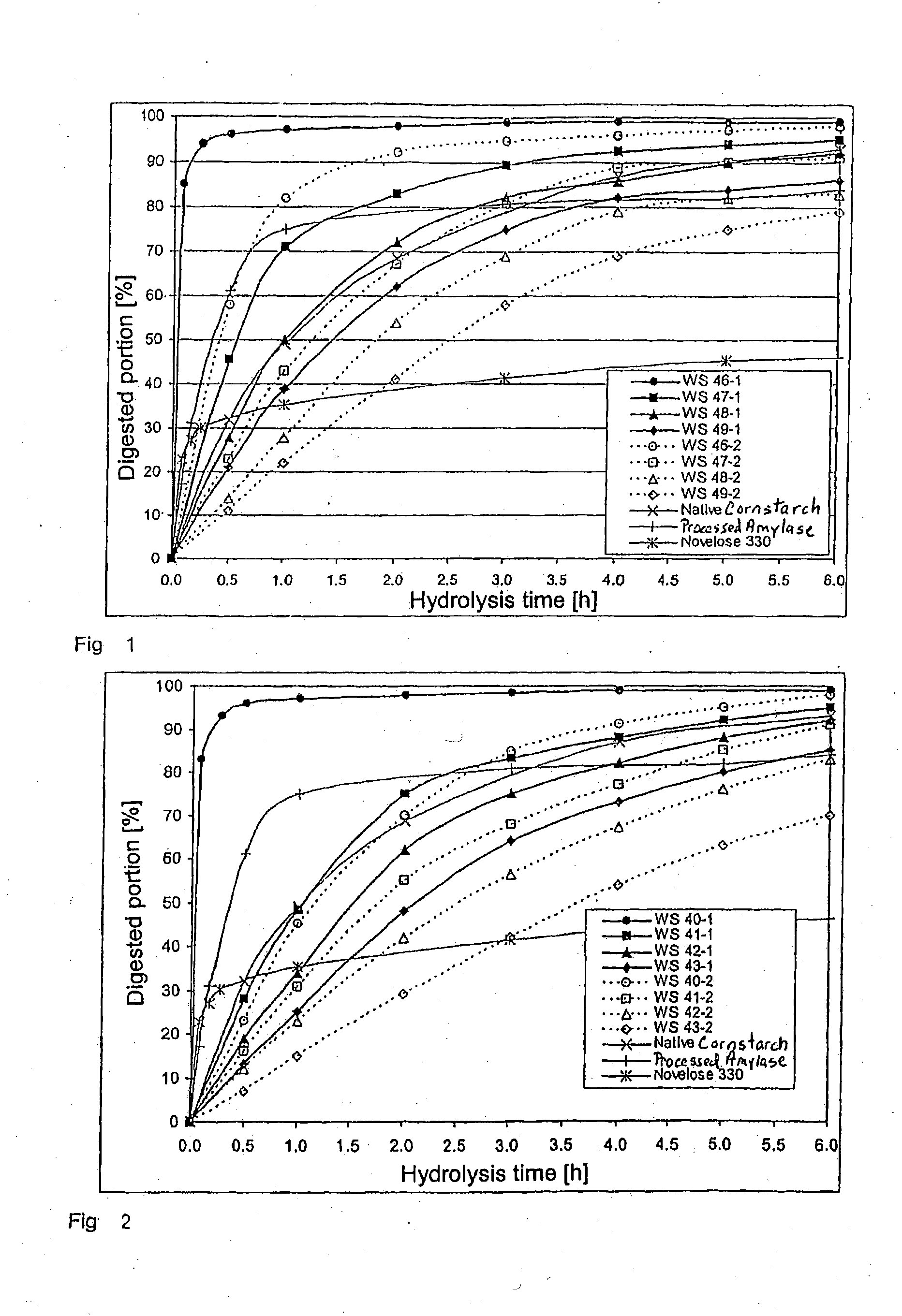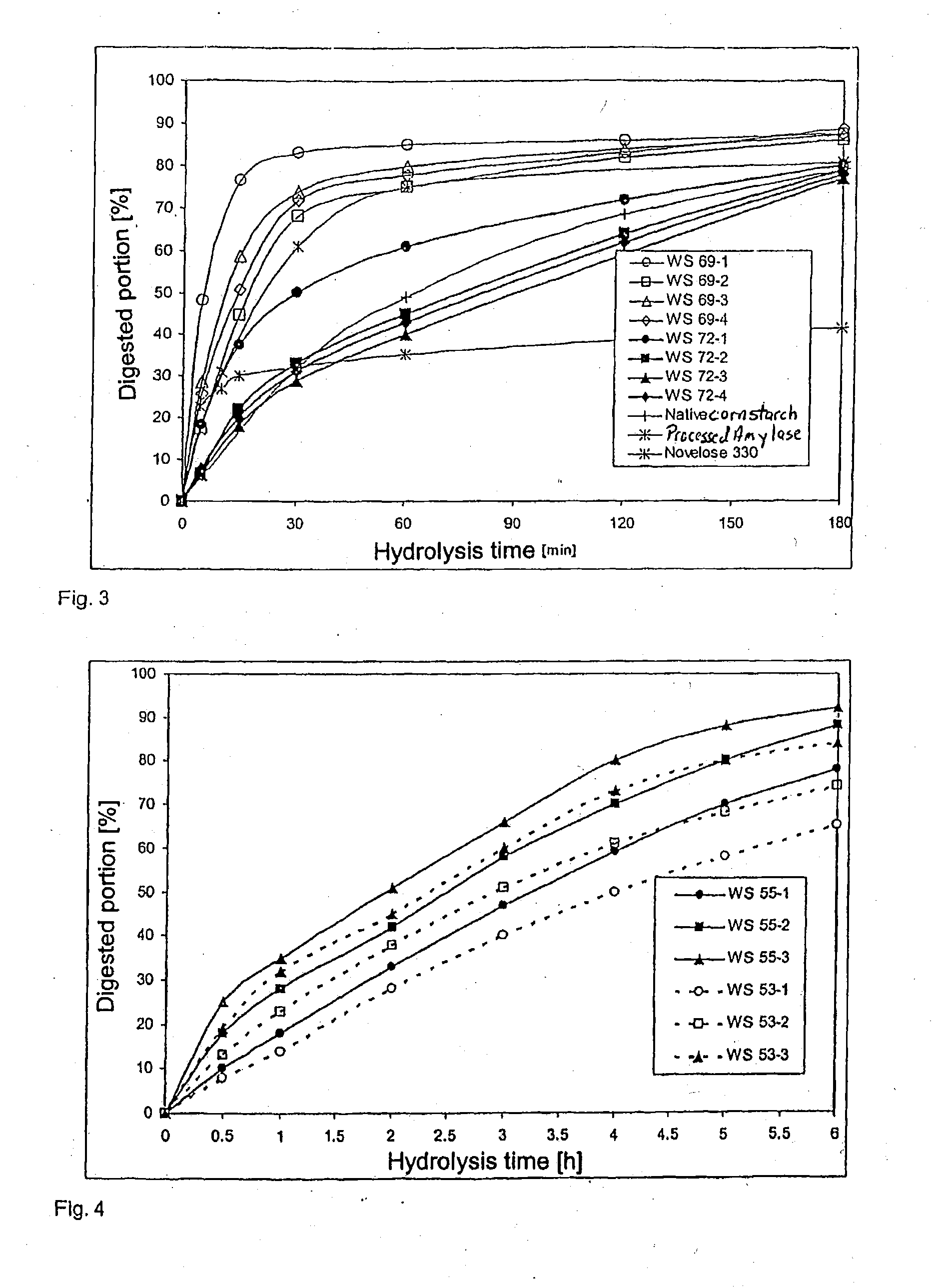Slowly digestible starch product
a technology of starch and slow digestion, applied in the field of starch products, can solve the problems of limited reduction of gi, high cost and cumbersome multi-stage processes, etc., and achieve the effects of low hydrolysis rate, sufficient thermal stability, and slow digestion
- Summary
- Abstract
- Description
- Claims
- Application Information
AI Technical Summary
Benefits of technology
Problems solved by technology
Method used
Image
Examples
examples 1
[0054]These examples illustrate the reduction in the initial hydrolysis rate and setting of a constant hydrolysis rate for various recipes, as well as the influence of conditioning parameters. Starch was processed in a Brabender kneader with a 50 ml kneading chamber with water added at speeds ranging from 80-120 RPM to form a thermoplastic compound. The kneading chamber was thermostated to 90° C. In most cases, the starch was used in pregelatinized form, since this enabled a reduction in preparation time. Comparative tests with native starch required a longer processing time, but yielded comparable results with otherwise identical parameters. In mixtures with SCA, the SCA (short-chain, mostly crystalline amylose with an average polymerization level of 24) was mixed with water at a ratio of 1:2, and converted into a low-viscous solution at 160° C. in autoclaves over a period of 5 min. This solution was then supplied at a temperature of roughly 90° C. to the at least partially thermop...
example 2
[0061]This example illustrates the use of the starch product as an ingredient. A reference recipe with 70% wheat flour, 7% butter, 15% isomalt, 5% fructose, 1% salt, 0.8% calcium phosphate, 0.4% malt and 0.8% baking powder relative to dry mass was kneaded into dough at a water content of 28%, and cookies were molded from this. The cookies were baked for 12 min at 210° C. The hydrolysis rate Ho in relation to the starch percentage was determined to be 900% / h. In the reference recipe, a portion of the wheat flour was replaced by a powder according to WS 42-2, so that the recipe contained 45% wheat flour and 25% WS 42-2. The hydrolysis rate Ho relative to the starch percentage was determined to be 600% / h. Therefore, the GI could be reduced in relation to the starch percentage from roughly 88 to 68, or from the high GI range to the medium GI range.
example 3
[0062]This example illustrates the use of the starch product as a food per se, in particular as a potato snack. The same procedure is followed as in Example 1, wherein potato granules and potato flakes in a ratio of 8:2 were used as the basic starch, 1.4% salt was added, the share of SCA relative to the starch as a whole was 20%, and Wo measured 29%. The homogenous mixture was pressed into 0.5 mm thick films, and these films were packed in saran foil and stored at 60° C. for 1 h at a constant Wo. The films Were then cut into 1 cm×1 cm pieces and dried at 75° C. to a water content of 10%. At this water content, the pieces were toasted for 1 min in a forced air oven at 220° C. The hydrolysis measurement yielded an Ho of 27% / h (corresponding roughly to a G1 value of approx. 15-20), and this value remained constant for roughly 2 h. Therefore, the product has a distinctly slowed release of glucose by comparison to native cornstarch (Ho=64% / h), and is suitable for sustained glucose supply...
PUM
 Login to View More
Login to View More Abstract
Description
Claims
Application Information
 Login to View More
Login to View More - R&D
- Intellectual Property
- Life Sciences
- Materials
- Tech Scout
- Unparalleled Data Quality
- Higher Quality Content
- 60% Fewer Hallucinations
Browse by: Latest US Patents, China's latest patents, Technical Efficacy Thesaurus, Application Domain, Technology Topic, Popular Technical Reports.
© 2025 PatSnap. All rights reserved.Legal|Privacy policy|Modern Slavery Act Transparency Statement|Sitemap|About US| Contact US: help@patsnap.com



